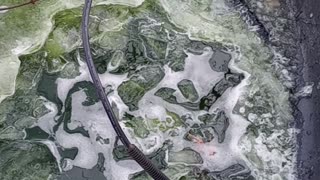Remarkable Progress in Aquatic Turtle Rehabilitation
Originally uploaded to my other accounts Oct 5, 2018
Critical to stabilizing aquatic patients in these cases, besides controlling blood loss, is immediate prevention of dehydration and tissue desiccation through placement of ointments, hydrogels, and other barrier dressings, and promotion of granulation as fast as possible. Aquatic turtles dehydrate VERY rapidly through such wounds and though their shell wounds and other trauma may be survivable, they will often end up dying within days from simple hydration losses from soft tissues exposure to outside air. Aquatic turtles cannot survive extended periods away from water sources in normal circumstances, and this is even more so the case when their shell has been opened to the environment. Barriers are critical to saving them in the short term. Over 16 years of rehabilitation work, I've developed and found high levels of successful outcomes when using a mixture I have developed containing a combination of a primary base of SSD, hydrolysate collagen (EMT gel brand), L-Proline powder, and a small amount of Vit. E oil. Sometimes, Manuka honey is also used, if silver sulfadiazine is not available to the at home rehabber. Immediately over this well mixed preparation, petrolatum infused gauze dressings are placed, which provide additional barrier protection from hydration losses. This is then covered with additional gauze, and then often finished with a transparent barrier dressing, such as SorbaView or Tegaderm, or, alternatively, simply with gauze tape and flexible self adhesive "Coban" or "Vet wrap", with several wraps around the shell. The wound is checked and repacked/cleaned about every 3 days, or as needed, depending on the severity of the underlying soft tissue damage, and the dressings replaced.
The key to this successful rehab technique is to NOT disturb this wound bed any more than necessary during the healing process, therefore, daily dressing changes are often NOT ADVISED, nor are additional chemical antimicrobial irrigation solutions on subsequent cleanings and repacking of the wound (chlorhexidine or povidone iodine), if there is no evidence of active infection in the wound bed. Simple sterile water for irrigation or normal saline will suffice for wound cleaning later. When sufficient healing has taken place that routine cleaning and repacking is no longer necessary, but the wound should still not be allowed to contact water for reasons of water intrusion into the body, or from bacterial contamination being a concern, then a more secure and longer term hydrocolloid waterproof dressing can be applied, such as J&J Tough Pads, which can allow even a turtle with a significant shell injury to return to the water for limited periods of time, for eating and hydration purposes, as most aquatic turtles will not eat unless they are in the water at the time. Because they also eliminate wastes when they are in the water, the wound should continue to be protected from contamination until a sufficiently thick layer of soft tissue granulation is in place. However, with appropriate dressings, the turtle can return to the water for ever increaing periods of time, even well before complete healing has taken place, and the stress upon the turtle, dehydration, and weight losses from reduced food intake can be mitigated to give better chances of a successful outcome to what would normally be a mortal injury.
𝕊𝕌𝔹𝕊ℂℝ𝕀𝔹𝔼! 𝕊𝕄𝔸𝕊ℍ +ℝ𝕌𝕄𝔹𝕃𝔼 𝔹𝕌𝕋𝕋𝕆ℕ!
Find me on MeWe:
https://mewe.com/p/reptilerescuerehabilitation
FB: https://www.facebook.com/ReptileRescue
When you donate, you're actively participating in saving animal lives. Your support helps keep the doors open and one more animal to be saved. 🦢🐤 🐍 🐢 🦎 🦆 🐇 🐁 🐟 🐖 🕊🐿🦨🐓 You can help by making a donation today.
PayPal: wfreptilerescue@gmail.com
Donate without a PayPal account at this checkout: https://www.paypal.com/cgi-bin/webscr?cmd=_donations&business=WFReptileRescue@gmail.com
-
 4:29
4:29
Reptile Rescue
4 months ago $0.03 earnedTurtle Tank Heater Failure During Polar Vortex 😨
27 -
 30:17
30:17
Stephen Gardner
3 hours agoEx-Secret Service REVEALS the TRUTH about Biden's Border Invasion!!
3.82K17 -
 1:39:28
1:39:28
Crain and Company
4 hours agoEA College Football Trailer Drops + Trey Wingo Talks PGA Championship and Scottie Scheffler
21.1K2 -
 3:04:20
3:04:20
Deprogrammed with Keri Smith
4 hours agoWhat the Woke Heard: Harrison Butker's Speech - LIVE Deprogrammed with Keri Smith
22.6K6 -
 17:29
17:29
Breaking Points
9 hours agoBREAKING: Iran President DEAD In Helicopter Crash, What's Next?
80.1K157 -
 57:54
57:54
Ben Shapiro
5 hours agoEp. 1968 - IRANIAN PRESIDENT DEAD IN HELICOPTER CRASH
70K105 -
 1:04:23
1:04:23
Russell Brand
8 hours agoBREAKING: IRAN PRESIDENT DEAD! Murder or accident? - Stay Free #369
189K341 -
 LIVE
LIVE
Tommy's Podcast
3 hours agoE458: CraigTV
207 watching -
 49:37
49:37
TENET Media
5 hours agoWinston Marshall Tricks Nancy Pelosi to Humiliate Herself | Dave Rubin & Isabel Brown
45.8K39 -
 2:54:35
2:54:35
IrishBreakdown
5 hours agoNotre Dame Recruiting Hour: Gordy Sulfsted Commits, DL Recruiting Talk
35.7K